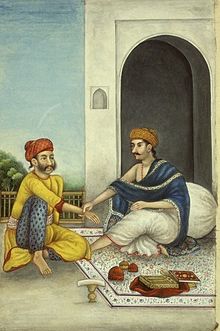Pulse diagnosis
[1][2] In Ayurveda, advocates claim that by taking a pulse examination, imbalances in the three Doshas (Vata, Pitta, and Kapha) can be diagnosed.
The traditional 29 pulse types include Floating, Soggy, Empty, Leathery, Scattered, Hollow, Deep, Firm, Hidden, Long, Surging, Short, Rapid, Hasty, Hurried, Moderate, Slow, Knotted, Full, Thready, Minute, Slippery, Choppy, Wiry, Tight, Weak, Regularly intermittent, rapid-irregular, and Stirred.
[7] For example, each of the paired pulse positions can represent the upper, middle and lower cavities of the torso, or are associated individually with specific organs.
The strengths and weaknesses of the positions are assessed at 3 depths each, namely fu (floating or superficial, 浮), zhong (middle, 中) and chen (deep, 沉).
The Canon of Medicine, published in 1025, included instructions on how to analyse the pulse and from such examination, physicians considered that they could identify problems ranging from jaundice to dropsy, diphtheria, pregnancy, and anxiety.

